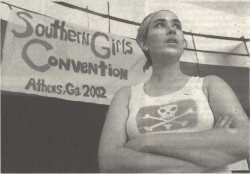 The Eighth Annual Southern Girls Convention will be held June 23-25, 2006, in Houston, Texas. Spread the word to anyone you think might be interested!
The Eighth Annual Southern Girls Convention will be held June 23-25, 2006, in Houston, Texas. Spread the word to anyone you think might be interested!
SGC is an unapologetically feminist, bottom-up, grassroots meeting. Each year for the past seven years, it’s brought out hundreds of rad folks to a different Southern community, with the help of a new set of local organizers, working together with organizers from years past (if you didn’t know, I’m one myself; together with my friends Claire Rumore and Ailecia Ruscin, I helped put on the third annual Southern Girls Convention, which drew about 600 radical activists to Auburn, Alabama). SGC is a space to meet and to talk and to learn from each other–learning skills for activism and everyday life, sharing our experiences organizing deep in the heart of the so-called Red States
, and taking it home to raise hell and work together to make our homes freer, safer, more just, and more loving places to be. It’s a place for Southern feminists to find each other, get together, work out our plans and our priorities, and begin to build the communities we want to live in, right in our own hometowns.

SGC’02 organizer Natasha Murphy
The convention’s started in Memphis, Tennessee, and has been held in Louisville, Kentucky; Auburn, Alabama; Athens, Georgia; Asheville, North Carolina; in Memphis, again; and in Baton Rouge, Louisiana. This year the seventh annual Southern Girls Convention will be held on June 23-25, 2006, in Houston, Texas. We’re working to remember, and to join, the radical tradition of the American South–the cradle of the Confederacy and the birthplace of the Klan, yes, but also–lest we forget–the home of the modern Civil Rights movement, the birthplace of SNCC, and the home of women like Sarah and Angelina Grimke, Ida B. Wells, Fannie Lou Hamer, Casey Hayden, Ti-Grace Atkinson, and Rita Mae Brown (just to name a few). In that tradition, we’re working to build an infrastructure for women’s liberation in the South — because the South is our home, it needs to change, and by God we’ll be the ones to do it.
There will be a weekend of workshops and social events for sharing skills, learning from each other about issues and campaigns, and just meeting and talking (or networking
, as they say) with each other. There will be music shows, free food, and a free arts and crafts fair to enjoy. There will also be childcare for children over the age of one, incidentally, and children will also be welcome in the convention space. Interested? Consider registering to attend. While you’re at it, if you have a skill you’d like to share or an issue or organization you’d like to talk with radical folks from across the South about, you should consider proposing a workshop! Part of the point of Southern Girls Convention is that we can all learn from each other; we don’t need professional activists coming in from the North to lecture us about how to organize ourselves. (N.B.: this doesn’t mean that professional activists from the North will be unwelcome at SGC; if you are one, we’d love for you to come. Just don’t expect it to be all about you!)
Here’s the announcement from this year’s organizers. Be sure to spread the word.
We are counting on you to spread the word for us! Please
forward this message to any friends, family, colleagues, bulletin
boards, listservs, or web pages that might be interested in the
event!
Eighth Annual Southern Girls Convention
June 23-35, 2006
Houston, Texas
WWW: http://southerngirlsconvention.org/2006/
WHAT IS SOUTHERN GIRLS CONVENTION?
The Southern Girls Convention is an annual grassroots meeting for
networking, organizing, educating, agitating, and activism, devoted to
empowering women, girls, and transfolks in the South, and to furthering the
struggle for social justice. Each year’s convention is hosted by a different
Southern community and facilitated by local organizers. Past conventions
have brought together hundreds of folks in Memphis, Tennessee; Louisville,
Kentucky; Auburn, Alabama; Athens, Georgia; Asheville, North Carolina; and
Baton Rouge, Louisiana.
This year, Southern Girls Convention invites activists from across the
country to meet in HOUSTON, TEXAS on the weekend of June 23-25, 2006.
Hundreds of activists will meet for discussion, action, and entertainment
devoted to building a feminist community in the South.
WHAT CAN I DO THERE?
Southern Girls Convention is based around discussions, workshops, and
presentations which give participants the opportunity to share skills, share
ideas, discuss important issues, organize campaigns, and have fun as a
ommunity. All workshops are organized and facilitated by the participants
themselves–that means you! (Have a great idea for a workshop? Fill out
our online form at http://southerngirlsconvention.org/2006/workshops.)
Other events will include an arts and craft fair, nightly music shows, and
tables for participants and organizations to display information, zines,
art, and things they have made.
SGC also allows hundreds of activists from across the country to meet,
network, strategize, and organize in their efforts on behalf of social
justice. Feel free to bring video projects, zines, writing, and anything you
are interested in sharing to the convention.
Childcare will be available at the convention space. Housing will be
provided for those who register in advance.
Past workshops at SGC have included:
Group discussions on fatphobia, abortion rights and access, radical
parenting, “100 Years of Revolutionary Wimmin,” the criminalization of
women, “Queer and Trans Youth in the South,” gender bias in schools, sexism
in the activist community, “Marginalization and Tokenization within the
Grrrl Movement,” roles and strategies for boys in the struggle against male
supremacy, and “Radical, Southern, and All Fired Up–Where Do We Go From
Here?”
Skill-sharing on radical cheerleading, community access television, gun
safety and self-defense, workplace union organizing, screen printing,
sexercises, Internet organizing, and how to start a consciousness-raising
group.
Organizing meetings for campaigns from Amnesty International, the
Coalition of Immokalee Workers, and Planned Parenthood, and state-by-state
caucuses for people to meet fellow organizers in their own area.
FOR MORE INFORMATION:
PLEASE FORWARD THIS E-MAIL FAR AND WIDE! Send it to friends and e-mail
lists, post it on your website, blog, or bulletin board… we are counting
on YOU to help us spread the word. A fresh copy of the e-mail can be sent
from our website at:
http://southerngirlsconvention.org/2006/spread-the-word
Thank you, and we hope to see you there!
Southern Girls Convention 2006 Organizers
Houston, Texas
I’m doing my part with this note and a banner at the top of the page. If you’d like to support SGC, here’s some things you can do to help out:
Further reading:

 The
The 